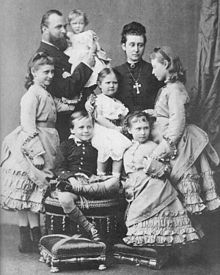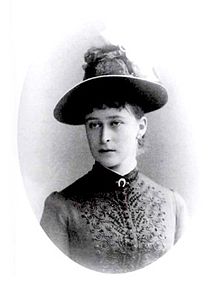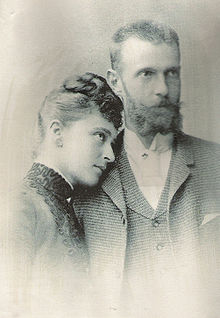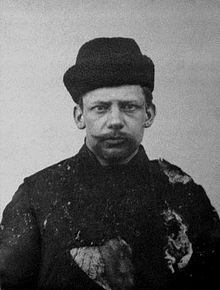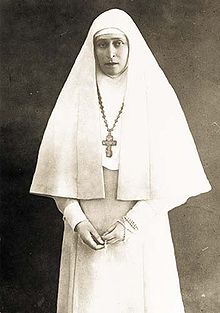- Princess Elisabeth of Hesse and by Rhine (1864–1918)
-
Princess Elisabeth of Hesse and by Rhine Grand Duchess Elizaveta Feodorovna of Russia 
Spouse Grand Duke Sergei Alexandrovich of Russia Full name Elisabeth Alexandra Louise Alice
After marriage: Elisabeth Feodorovna RomanovaHouse House of Hesse
House of Holstein-Gottorp-RomanovFather Louis IV, Grand Duke of Hesse Mother Princess Alice of the United Kingdom Born 1 November 1864
Bessungen, Hesse, GermanyDied 18 July 1918 (aged 53)
Alapaevsk, RussiaBurial Church of Maria Magdalene, Jerusalem, Israel Grand Ducal Family of
Hesse and by Rhine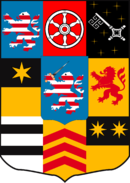
Louis IV Children Victoria, Marchioness of Milford Haven Grand Duchess Elizaveta Feodorovna of Russia Irene, Princess Heinrich of Prussia Ernest Louis Prince Friedrich Alexandra Feodorovna, Empress of Russia Princess Marie Grand Duchess Elizabeth Feodorovna of Russia (Elizabeth Feodorovna Romanova, Russian: Елизавета Фëдоровна Романова) canonized as St. Elizabeth Romanova (1 November 1864 – 18 July 1918) was a German princess of the House of Hesse, and the wife of Grand Duke Sergei Alexandrovich of Russia, fifth son of Emperor Alexander II of Russia and Princess Marie of Hesse and the Rhine. An older sister of Alexandra, the last Russian Empress, Elizabeth became famous in Russian society for her beauty and charitable works among the poor. After the Socialist Revolutionary Party's Combat Organization murdered her husband with a dynamite bomb in 1905, Elizabeth publicly forgave Sergei's murderer and campaigned without success for him to be pardoned. She then departed the Imperial Court and became a nun, founding the Marfo-Mariinsky Convent dedicated to helping the downtrodden of Moscow. In 1918 she was arrested and ultimately buried alive by the Bolsheviks. In 1981 Elizabeth was canonized by the Russian Orthodox Church Outside of Russia, and in 1992 by the Moscow Patriarchate.
Contents
Princess of Hesse
Grand Duchess Elisabeth was born Her Grand Ducal Highness Princess Elisabeth Alexandra Louise Alice of Hesse and by Rhine on 1 November 1864. She was the second child of Grand Duke Ludwig IV of Hesse and by Rhine and British Princess Alice. Through her mother, she was a granddaughter of Queen Victoria. Princess Alice chose the name "Elisabeth" for her daughter after visiting the shrine of St. Elizabeth of Hungary, ancestress of the House of Hesse, in Marburg. Alice so admired St. Elizabeth that she decided to name her new daughter after her. Elizabeth was known as "Ella" within her family.
Though she came from one of the oldest and noblest houses in Germany, Elisabeth and her family lived a rather modest life by Royal standards. The children swept the floors and cleaned their own rooms, while their mother sewed dresses herself for the children. During the Austro-Prussian War, Princess Alice often took Elisabeth with her while visiting wounded soldiers in a nearby hospital. In this relatively happy and secure environment, Elisabeth grew up surrounded by English domestic habits, and English became her first language. Later in life, she would tell a friend that, within her family, she and her siblings spoke English to their mother and German to their father.
In the autumn of 1878, diphtheria swept through the Hesse household, killing Elizabeth's youngest sister, Marie on 16 November, as well as her mother Alice on 14 December. Elizabeth had been sent away to her paternal grandmother's home at the beginning of the outbreak and she was the only member of her family to remain unaffected. When she was finally allowed to return home, she described the meeting as "terribly sad" and said that everything was "like a horrible dream".[citation needed]
Admirers and suitors
Charming and with a very accommodating personality, Elizabeth was considered by many historians and contemporaries to be one of the most beautiful women in Europe at that time. As a young woman, she caught the eye of her elder cousin, the future German Emperor William II. He was a student then at Bonn University, and on weekends he often visited his Aunt Alice and his Hessian relatives. During these frequent visits, he fell in love with Elizabeth, writing numerous love poems and regularly sending them to her. Flattered as she may have been by his attentions, Elizabeth was not attracted to William. She politely declined him, and the resulting heartbreak caused him to give up his studies and return to Prussia.
Besides William II, she had many other admirers, among them Lord Charles Montagu, the second son of the 7th Duke of Manchester, and Henry Wilson, later a distinguished soldier.
Yet another of Elizabeth's suitors was the future Frederick II, Grand Duke of Baden, William's first cousin. Queen Victoria described him as "so good and steady", with "such a safe and happy position," that when Elizabeth declined to marry him the Queen "deeply regretted it". Frederick's grandmother, the Empress Augusta, was so furious at Elizabeth's rejection of Frederick that it took some time for her to forgive Elizabeth.
Other admirers included:
- Elizabeth's husband's cousin, Grand Duke Konstantin Konstantinovich (the poet KR). He wrote a poem about her first arrival in Russia, and the general impression she made to all the people present at the time.
- Prince Felix Yussupov considered her a second mother, and stated in his memoirs that she helped him greatly during the most difficult moments of his life.
- As a young girl, Queen Marie of Romania was very fascinated with her Cousin Ella, and would later describe her beauty and sweetness in her memoirs as "a thing of dreams".
- The French Ambassador to the Russian court, Maurice Paleologue, wrote in his memoirs how Elizabeth was capable of arousing what he described as "profane passions".
But it was a Russian Grand Duke who ultimately won Elizabeth's heart. Elizabeth’s great-aunt, Empress Maria Alexandrovna of Russia, was a frequent visitor to Hesse. During these visits, she was usually accompanied by her youngest sons, Sergei and Paul. Elizabeth had known the boys since they were children, and she initially viewed them as haughty and reserved. Sergei, especially, was a very serious young man, intensely religious, and he found himself attracted to Elizabeth after seeing her as a young woman for the first time in several years.
At first, Sergei made little impression on Elizabeth. But after the death of both of Sergei’s parents within the same year, the shock of his loss caused Elizabeth to gradually see Sergei “in a new light”. She had felt this same grief after the death of her mother, and their other similarities (both were artistic and religious) began to draw them closer together. It was said that Sergei was especially attached to Elizabeth because she had the same character as his beloved mother. So when Sergei proposed to her for the second time, she accepted—much to the chagrin of her grandmother Queen Victoria.
Grand Duchess of Russia
Sergei and Elizabeth married on 15 (3) June 1884, at the Chapel of the Winter Palace in St. Petersburg. She became Grand Duchess Elizabeth Feodorovna. The new Grand Duchess made a good first impression on her husband’s family and the Russian people. “Everyone fell in love with her from the moment she came to Russia from her beloved Darmstadt”, wrote one of Sergei's cousins. The couple settled in the Beloselsky-Belozersky Palace in St. Petersburg; after Sergei was appointed Governor-General of Moscow in 1892, they resided in one of the Kremlin palaces. During the summer, they stayed at Il’yinskoe, an estate outside Moscow that Sergei had inherited from his mother.
The couple never had children of their own, but their Il’yinskoye estate was usually filled with parties that Elizabeth organized especially for children. They eventually became the foster parents of Grand Duke Dmitri Pavlovich and Grand Duchess Maria Pavlovna, Sergei’s niece and nephew.
Although Elizabeth was not legally required to convert to Russian Orthodoxy from her native Lutheran religion, she voluntarily chose to do so in 1891. Although some members of her family questioned her motives, her conversion appears to have been sincere.
On 18 February 1905, Sergei was assassinated in the Kremlin by the Socialist-Revolutionary, Ivan Kalyayev. The event came as a terrible shock to Elizabeth, but she never lost her calm. Her niece Marie later recalled that her aunt’s face was “pale and stricken rigid” and she would never forget her expression of infinite sadness. In her rooms, said Marie, Elizabeth “let herself fall weakly into an armchair...her eyes dry and with the same peculiar fixity of gaze, she looked straight into space, and said nothing.” As visitors came and went, she looked without ever seeming to see them. Throughout the day of her husband's murder, Elizabeth refused to cry. But Marie recalled how her aunt slowly abandoned her rigid self-control, finally breaking down into sobs. Many of her family and friends feared that she would suffer a nervous breakdown, but she quickly recovered her equanimity.
According to Edvard Radzinsky,
"Elizabeth spent all the days before the burial in ceaseless prayer. On her husband's tombstone she wrote: 'Father, release them, they know not what they do.' She understood the words of the Gospels heart and soul, and on the eve of the funeral she demanded to be taken to the prison where Kalyayev was being held. Brought into his cell, she asked, 'Why did you kill my husband?' 'I killed Sergei Alexandrovich because he was a weapon of tyranny. I was taking revenge for the people.' 'Do not listen to your pride. Repent... and I will beg the Sovereign to give you your life. I will ask him for you. I myself have already forgiven you.' On the eve of revolution, she had already found a way out; forgiveness! Forgive through the impossible pain and blood -- and thereby stop it then, at the beginning, this bloody wheel. By her example, poor Ella appealed to society, calling upon the people to live in Christian faith. 'No!" replied Kalyayev. 'I do not repent. I must die for my deed and I will... My death will be more useful to my cause than Sergei Alexandrovich's death.' Kalyayev was sentenced to death. 'I am pleased with your sentence,' he told the judges. 'I hope that you will carry it out just as openly and publicly as I carried out the sentence of the Socialist Revolutionary Party. Learn to look the advancing revolution right in the face.'"[1]
Kalyayev was hanged on 23 May 1905.
Religious life
After Sergei’s death, Elizabeth wore mourning clothes and became a vegetarian. In 1909, she sold off her magnificent collection of jewels and sold her other luxurious possessions; even her wedding ring was not spared. With the proceeds she opened the Convent of Sts. Martha and Mary and became its abbess. She soon opened a hospital, a chapel, a pharmacy and an orphanage on its grounds. Elizabeth and her nuns worked tirelessly among the poor and the sick of Moscow. She often visited Moscow’s worst slums and did all she could to help alleviate the suffering of the poor.
For many years, Elizabeth's institution helped the poor and the orphans in Moscow by fostering the prayer and charity of devout women. Here, there arose a vision of a renewed diaconate for women, one that combined intercession and action in the heart of a disordered world. Although the Orthodox Church rejected her idea of a female diaconate, it did bless and encourage Elizabeth's many charitable efforts.
Murder
In 1918, Lenin ordered the Cheka to arrest Elizabeth. They then exiled her first to Perm, then to Yekaterinburg, where she spent a few days and was joined by others: the Grand Duke Sergei Mikhailovich Romanov; Princes Ioann Konstantinovich, Konstantin Konstantinovich, Igor Konstantinovich and Vladimir Pavlovich Paley; Grand Duke Sergei's secretary, Feodor Remez; and Varvara Yakovleva, a sister from the Grand Duchess's convent. They were all taken to Alapaevsk on 20 May 1918, where they were housed in the Napolnaya School on the outskirts of the town.
At noon on 17 July, Cheka Officer Petr Startsev and a few Bolshevik workers came to the school. They took from the prisoners whatever money they had left and announced that they would be transferred that night to the Upper Siniachikhensky factory compound. The Red Army guards were told to leave and Cheka men replaced them. That night the prisoners were awakened and driven in carts on a road leading to the village of Siniachikha, some 18 kilometres from Alapaevsk where there was an abandoned iron mine with a pit, twenty metres deep. Here they halted. The Cheka beat all the prisoners before throwing their victims into this pit, Elizabeth being the first. Hand grenades were then hurled down the shaft, but only one victim, Feodor Remez, died as a result of the grenades.
According to the personal account of Vassili Ryabov, one of their killers, Elizabeth and the others survived the initial fall into the mine, prompting Ryabov to toss in a grenade after them. Following the explosion, he claimed to have heard Elizabeth and the others singing an Orthodox hymn from the bottom of the shaft.[2] Unnerved, Ryabov threw down a second grenade, but the singing continued. Finally a large quantity of brushwood was shoved into the opening and set alight, upon which Ryabov posted a guard over the site and departed.
Early on 18 July 1918, the head of the Alapaevsk Cheka, Abramov, and the head of the Yekaterinburg Regional Soviet, Beloborodov, who had been involved in the murders of the Imperial Family, exchanged a number of telegrams in a pre-arranged plan saying that the school had been attacked by an "unidentified gang". A month later, Alapaevsk fell to the White Army of Admiral Alexander Kolchak.
Legacy
On 8 October 1918, White Army soldiers discovered the remains of Elizabeth and her companions, still within the shaft where they had been murdered. Elizabeth had died of wounds sustained in her fall into the mine, but before her death had still found strength to bandage the head of the dying Prince Ioann. Her remains were removed and ultimately taken to Jerusalem, where they lie today in the Church of Maria Magdalene.
Elizabeth was canonized by the Russian Orthodox Church Outside of Russia in 1981, and in 1992 by the Moscow Patriarchate as New Martyr Elizabeth. Her principal shrines are the Marfo-Mariinsky Convent she founded in Moscow, and the St. Mary Magdalene Convent on the Mount of Olives, which she and her husband helped build, and where her relics (along with the Nun Barbara) are enshrined. She is one of the ten 20th-century martyrs from across the world who are depicted in statues above the Great West Door of Westminster Abbey, London, England.
A statue of Elizabeth was erected in the garden of her convent after the collapse of the Soviet Union. Its inscription reads: "To the Grand Duchess Elizabeth Feodorovna: With Repentance."
Titles and styles
- Her Grand Ducal Highness Princess Elisabeth of Hesse and the Rhine (1864–1884)
- Her Imperial Highness Grand Duchess Elizaveta Feodorovna of Russia (1884–1918)
Ancestry
Notes
- ^ Edvard Radzinsky, The Last Tsar, page 82.
- ^ Murder of the Grand Duchess Elizabeth at www.serfes.org
Further reading
- Paleologue, Maurice. An Ambassador's Memoirs, 1922
- Grand Duchess Marie of Russia. Education of a Princess, 1931
- Queen Marie of Romania. The Story of My Life, 1934
- Almedingen, E.M. An Unbroken Unity, 1964
- Duff, David. Hessian Tapestry, 1967
- Millar, Lubov, Grand Duchess Elizabeth of Russia, US edition, Redding, CA., 1991, ISBN 1-879066-01-7
- Mager, Hugo. Elizabeth, Grand Duchess of Russia, 1998, ISBN 0786705094
- Zeepvat, Charlotte. Romanov Autumn, 2000, ISBN 5827600342
- Belyakova, Zoia. The Romanovs: the Way It Was, 2000, ISBN 5827600342
- Warwick, Christopher Ella: Princess, Saint and Martyr, 2007, ISBN 047087063X
- Croft, Christina Most Beautiful Princess — A Novel Based on the Life of Grand Duchess Elizabeth of Russia, 2008, ISBN 0955985307
See also
- Canonization of the Romanovs
External links
Orthodox sources
- The Life of the Holy Royal Martyr Grand Duchess Elizabeth
- Life of the Holy New Martyr Grand Duchess Elizabeth, by Metropolitan Anastassy
- Pilgrimage to Alapaevsk
- Photo Library of St. Elizabeth
- OrthodoxWiki:Elizabeth the New Martyr
Orthodox hymns to St. Elizabeth
- Akathist to the New Martyr Elizabeth
- Canon to the New Martyrs Grand Duchess Elizabeth and Nun Barbara
Secular sources
- Murder details
- The Alexander Palace Time Machine
- American Reporter Interviews Elizabeth in 1917
- HIH Grand Duchess Elisabeth Feodorovna by Countess Alexandra Olsoufieff
- Elizabeth and Romanov Discussion Forum
- Murder of the Romanovs at Alapayevsk
Grand Duchesses of Russia by marriage 1st generation 2nd generation - none
3rd generation 4th generation 5th generation - Elizabeth Alexeievna of Baden
- Anna Feodorovna of Saxe-Coburg-Saalfeld
- Alexandra Feodorovna of Prussia
- Elena Pavlovna of Württemberg
6th generation - Maria Alexandrovna of Hesse-Darmstadt
- Alexandra Iosifovna of Saxe-Altenburg
- Alexandra Petrovna of Oldenburg
- Olga Feodorovna of Baden
7th generation - Maria Feodorovna (Dagmar of Denmark)
- Maria Pavlovna of Mecklenburg-Schwerin
- Anastasia Nikolaevna of Montenegro
- Elizabeth Feodorovna of Hesse and by Rhine
- Elizaveta Mavrikievna of Saxe-Altenburg
- Alexandra Georgievna of Greece and Denmark
- Maria Georgievna of Greece and Denmark
- Militza Nikolaevna of Montenegro
- Xenia Alexandrovna of Russia**
8th generation 9th generation - Leonida Georgievna Bagration of Mukhrani***
- *never converted to Orthodoxy
- **also a Grand Duchess of Russia by birth
- ***title granted by Grand Duke Vladimir Cyrillovich
1st Generation Louise, Princess Louis of Anhalt-Köthen2nd Generation Princess Elizabeth · Marie, Empress of Russia3rd Generation Anna, Grand Duchess of Mecklenburg-Schwerin4th Generation Victoria, Marchioness of Milford Haven · Elizabeth Feodorovna, Grand Duchess Sergei Alexandrovich of Russia · Irene, Princess Heinrich of Prussia · Alix, Empress of Russia · Princess Marie5th Generation Princess Elisabeth6th Generation Categories:- Burials at the Church of Maria Magdalene
- Converts to Eastern Orthodoxy from Protestantism
- German nuns
- Russian nuns
- Russian-German people
- Eastern Orthodox people executed by the Soviet Union
- Executed royalty
- Extrajudicial killings
- Former Lutherans
- German people executed by the Soviet Union
- House of Hesse-Darmstadt
- House of Holstein-Gottorp-Romanov
- Ladies of the Royal Order of Victoria and Albert
- Murdered Russian royalty
- People murdered in the Soviet Union
- Russian grand duchesses by marriage
- Russian saints
- Victims of Red Terror in Soviet Russia
- 1864 births
- 1918 deaths
- 19th-century Christian saints
- 20th-century Christian saints
- 19th-century Christian female saints
- 20th-century Christian female saints
- 19th-century venerated Christians
- 20th-century venerated Christians
Wikimedia Foundation. 2010.

